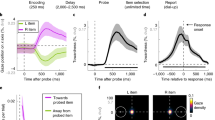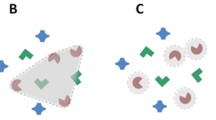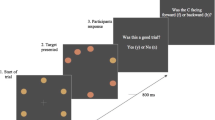Abstract
This study investigated the usefulness of explicit spatial coordinates from eye movements for the precision of covert shifts of attention within dense arrays of items. Observers shifted their attention covertly from one item to the next in response to a series of beeps and reported the color of the disc on which the series ended, providing an estimate of the accuracy of the “attentional walk”. We compared performance in this task when only covert shifts of attention were done to performance when observers first executed an explicit eye movement to the starting point of the attentional walk before beginning the covert attentional walk. The hypothesis was that the eye movement would activate explicit coordinates of the starting point of the attentional walk within brain systems that are involved in controlling both shifts of attention and eye movements. This in turn would provide an anchor for the attentional walk, thereby improving performance. The evidence did not support this hypothesis. Performance was no better with an explicit eye movement prior to the attentional walk than without one. This suggests that covert orienting—shifting attention—and overt orienting—shifting the eyes—access the same coordinate system and therefore activating new coordinates interferes with the old ones, no matter what the system of orienting is.


Similar content being viewed by others
References
Abrams RA, Dobkin RS (1994) Inhibition of return: effects of attentional cuing on eye movement latencies. J Exp Psychol Hum Percept Perform 20:467–477
Brainard DH (1997) The psychophysics toolbox. Spat Vis 10:433–436
Briand KA (1998) Feature integration and spatial attention: more evidence of a dissociation between endogenous and exogenous orienting. J Exp Psychol Hum Percept Perform 24:1243–1256
Briand KA, Klein RM (1987) Is Posner’s “beam” the same as Treisman’s “glue”?: on the relation between visual orienting and feature integration theory. J Exp Psychol Hum Percept Perform 13:228–241
Carello CD, Krauzlis RJ (2004) Manipulating intent: evidence for a causal role of the superior colliculus in target selection. Neuron 43:575–583
Cheal M, Chastain G, Lyon D (1998) Inhibition of return in visual identification tasks. Vis Cogn 5:365–388
Corbetta M (1998) Frontoparietal cortical networks for directing attention and the eye to visual locations: identical, independent, or overlapping neural systems? Proc Natl Acad Sci USA 95:831–838
Corbetta M, Shulman GL (2002) Control of goal-directed and stimulus-driven attention in the brain. Nat Rev Neurosci 3:201–215
de Haan B, Morgan PS, Rorden C (2008) Covert orienting of attention and overt eye movements activate identical brain regions. Brain Res 1204:102–111
He S, Cavanagh P, Intriligator J (1997) Attentional resolution. Trends Cogn Sci 1:115–121
Hoffman JE (1975) Hierarchical stages in the processing of visual information. Percept Psychophys 18:348–354
Hoffman JE, Subramaniam B (1995) The role of visual attention in saccadic eye movements. Percept Psychophys 57:787–795
Ignashchenkova A, Dicke PW, Haarmeier T, Thier P (2003) Neuron-specific contribution of the superior colliculus to overt and covert shifts of attention. Nat Neurosci 7:56–64
Intriligator J, Cavanagh P (2001) The spatial resolution of visual attention. Cogn Psychol 43:171–216
Jonides J, Yantis S (1988) Uniqueness of abrupt visual onset in capturing attention. Percept Psychophys 43:346–354
Klein RM (1994) Perceptual-motor expectancies interact with covert visual orienting under conditions of endogenous but not exogenous control. Can J Exp Psychol 48:167–181
Klein RM (2000) Inhibition of return. Trends Cogn Sci 4:138–147
Kowler E, Anderson E, Dosher B, Blaser E (1995) The role of attention in the programming of saccades. Vis Res 35:1897–1916
Kustov AA, Robinson DL (1996) Shared neural control of attentional shifts and eye movements. Nature 384:74–77
Lu ZL, Dosher BA (2000) Spatial attention: different mechanisms for central and peripheral temporal precues? J Exp Psychol Hum Percept Perform 26:1534–1548
McPeek RM, Keller EL (2002) Saccade target selection in the superior colliculus during a visual search task. J Neurophysiol 88:2019–2034
McPeek RM, Keller EL (2004) Deficits in saccade target selection after inactivation of superior colliculus. Nat Neurosci 7:757–763
Moore T, Fallah M (2001) Control of eye movements and spatial attention. Proc Natl Acad Sci USA 98:1273–1276
Moore T, Fallah M (2004) Microstimulation of the frontal eye field and its effects on covert spatial attention. J Neurophysiol 91:152–162
Moore CM, Lanagan-Leitzel LK, Chen P, Halterman R, Fine EM (2007) Nonspatial attributes of stimuli can influence spatial limitations of attentional control. Percept Psychophys 69:363–371
Moore CM, Lanagan-Leitzel L, Fine E (2008) Distinguishing between the precision of attentional localization and attentional resolution. Percept Psychophys 70:573–582
Moore CM, Hein E, Grosjean M, Rinkenauer G (2009) Limited influence of perceptual organization on the precision of attentional control. Atten Percept Psychophys 71:971–983
Müller HJ, Findlay J (1988) The effect of visual attention on peripheral discrimination thresholds in single and multiple element displays. Acta Psychol 69:129–155
Müller HJ, Rabbitt PM (1989) Reflexive and voluntary orienting of visual attention: time course of activation and resistance to interruption. J Exp Psychol Hum Percept Perform 15:315–330
Müller JR, Philiastides MG, Newsome W (2005) Microstimulation of the superior colliculus focuses attention without moving the eyes. Proc Natl Acad Sci USA 102:524–529
Palmer J, Moore CM (2008) Using a filtering task to measure the spatial extent of selective attention. Vis Res. doi:10.1016/j.visres.2008.02.022
Pelli DG (1997) The VideoToolbox software for visual psychophysics: transforming numbers into movies. Spat Vis 10:437–442
Posner MI (1980) Orienting of attention. Q J Exp Psychol 32:3–25
Posner MI, Cohen Y (1984) Components of visual orienting. In: Bouma H, Bouwhuis DG (eds) Attention and performance X. Erlbaum, Hillsdale, NJ, pp 531–556
Prinzmetal W, McCool C, Park S (2005) Attention: reaction time and accuracy reveal different mechanisms. J Exp Psychol Gen 134:73–92
Rafal RD, Calabresi PA, Brennan CW, Sciolto TK (1989) Saccade preparation inhibits reorienting to recently attended locations. J Exp Psychol Hum Percept Perform 15:673–685
Rafal RD, Davies J, Lauder J (2006) Inhibitory tagging at subsequently fixated locations: generation of “inhibition of return” without saccade inhibition. Vis Cogn 13:308–323
Remington R, Johnston J, Yantis S (1992) Involuntary attentional capture by abrupt onsets. Percept Psychophys 51:279–290
Riggio L, Kirsner K (1997) The relationship between central cues and peripheral cues in covert visual orientation. Percept Psychophys 59:885–899
Rizzolatti G, Riggio L, Dascola I, Umiltá C (1987) Reorienting attention across the horizontal and vertical meridians: evidence in favor of a premotor theory of attention. Neuropsychologia 25:31–40
Ro T, Pratt J, Rafal R (2000) Inhibition of return in saccadic eye movements. Exp Brain Res 130:264–268
Schall JD (2004) On the role of frontal eye field in guiding attention and saccades. Vis Res 44:1453–1467
Thompson KG, Bichot NP, Schall JD (2001) From attention to action in frontal cortex. In: Braun J, Koch C, Davis J (eds) Visual attention and cortical circuits. MIT Press, Cambridge, pp 137–157
Acknowledgments
The work reported here was supported in part by NIH grant MH067793. We would like to thank Sergey Yurgensen for technical assistance and two anonymous reviewer for their comments.
Author information
Authors and Affiliations
Corresponding author
Rights and permissions
About this article
Cite this article
Hein, E., Moore, C.M. Explicit eye movements failed to facilitate the precision of subsequent attentional localization. Exp Brain Res 197, 387–393 (2009). https://doi.org/10.1007/s00221-009-1927-x
Received:
Accepted:
Published:
Issue Date:
DOI: https://doi.org/10.1007/s00221-009-1927-x




